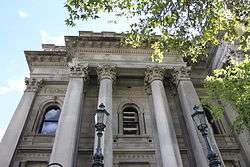Parliament House, Adelaide
The first completed western wing is to the left, adjacent to the Old Parliament House.


Parliament House, on the corner of North Terrace and King William Road in the Adelaide city centre, is the seat of the Parliament of South Australia. It was built to replace the adjacent and overcrowded Parliament House, now referred to as "Old Parliament House". Due to financial constraints, the current Parliament House was constructed in stages over 65 years from 1874 to 1939.
The 47-seat House of Assembly (lower house) consists of 24 Labor, 21 Liberal and 2 independents, Geoff Brock and Martin Hamilton-Smith.
Following the 2014 election, the lower house consisted of 23 Labor, 22 Liberal and 2 independents, Geoff Brock and Bob Such. Martin Hamilton-Smith became an independent shortly after the election, reducing the Liberals to 21 seats. Both Hamilton-Smith and fellow independent Geoff Brock are in cabinet and provide confidence and supply while retaining the right to vote on conscience. Labor went from minority to majority government when Nat Cook won the 2014 Fisher by-election which was triggered by the death of Bob Such.[1]
The 22-seat Legislative Council (upper house) consists of 7 Labor, 8 Liberal, 2 Green, 2 Family First, 1 Dignity for Disability and 2 independents, John Darley and Bernard Finnigan.
History
A commission, appointed by the Governor of South Australia, was set up in 1874 to adjudicate a design competition for the new building. A design by prominent Adelaide architect Edmund Wright and his partner Lloyd Taylor was selected winner. This Greek Revival design featured ornate columns of the Corinthian order, impressive towers and a grand dome. However, lack of funds resulted in the towers and dome being removed from the design that was implemented. Occasionally, plans to complete the building by constructing the towers and dome are revived, but none has ever been implemented.
Parliament House was built with Kapunda marble and West Island granite. Construction began on the West Wing in 1874 and was completed in 1889 at a cost of £165,404. The West Wing contained the new chamber for the South Australian House of Assembly and associated offices. The South Australian Legislative Council continued in the Old Parliament House next door. Economic depression in the 1890s delayed the completion of Parliament House, and it was not until 1913 that plans were sketched for the East Wing. The outbreak of the Great War again delayed construction.
The project was taken up again in the 1930s following a £100,000 gift by Sir John Langdon Bonython.He Sent a cheque to the State Premier with a note indicating the money should be used to complete the half finished Parliament house on North Terrace. The project also functioned as a job generation scheme to alleviate the mass unemployment of the Great Depression. Work began on the East Wing in 1936, the year of South Australia's centenary, and was completed three years later in 1939 at a cost of £241,887. When finally completed, the British Houses Of Parliament were so delighted the building was completed after such a long time they organized to have the Lion forming part of a Royal Coat of Arms at the Westminster Houses Of Parliament removed from the stonework and shipped to Adelaide. It was presented to The Parliament Of South Australia by The Empire Parliamentary Association United Kingdom in 1939. The statue and plaque are located in a setting at the front of the building.[2]
The completed Parliament House was formally opened on 5 June 1939 by Lord Gowrie, the 10th Governor-General of Australia, (and also a former Governor of South Australia).
References
- ↑ Fisher by-election win for Labor gives Weatherill Government majority in SA: ABC 13 December 2014
- ↑ Image of Lion and Plaque Located on North Terrace, Adelaide
External links
| Wikimedia Commons has media related to Parliament House, Adelaide. |
| ||||||||||
Coordinates: 34°55′16″S 138°35′55″E / 34.921096°S 138.598554°E

